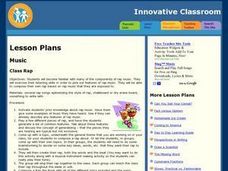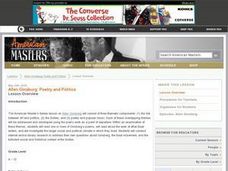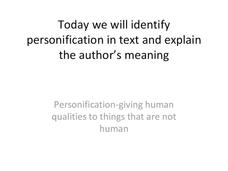TED-Ed
A-rhythm-etic. The Math Behind the Beats
Your learners will dance in their seats as this talented drummer connects math to music in a short video clip. Clayton Cameron shows how math puts the "cool" in various genres of music, including jazz, hip-hop, pop,...
Curated OER
Marching to the Beat of a Different Drum
Henry David Thoreau and Linda Ronstadt? Ann Tyler and Pete Townshend? Joyce Carol Oates and Pearl Jam? This richly detailed plan pairs classic literature with contemporary music and asks learners to analyze how the theme of conformity is...
Curated OER
Class Rap
Students explore rap music and its components. They listen to examples of rap music and discuss their common features. After selecting a topic, they compose a rap with both words and the beat and sing it to the class. As a class they...
Curated OER
1920s Variety Show
To better understand the cultural achievements of the Harlem Renaissance and become familiar with its major figures, class members examine a painting by Aaron Douglas and a poem by Langston Hughes and compare how the artists develop...
Teachers.net
How to Write a Movie Review from a Pet's Perspective
When would two paws up denote a blockbuster film in your classroom? Only when young writers create movie reviews from a pet's perspective in this imaginative expository writing practice. This engaging topic begins with a class discussion...
Curated OER
Allen Ginsberg: Poetry and Politics
Students explore the poetry of Allen Ginsberg. They read and analyze poems by Allen Ginsberg, conduct Internet research, collect examples of art of the 60s, and create a presentation.
Curated OER
Monster: Guided Imagery
How would you feel if you were on trial for murder—and you were only 16 years old? Put yourself in Steve Harmon's shoes before reading Monster by Walter Dean Myers. Kids listen to music that fits the theme of the book before...
Curated OER
Creating Interesting Characters
What makes a story interesting? Complex characters! As part of a series of worksheets that prepares middle schoolers to write their own novel, the exercises included explain the role of the protagonist, the antagonist, and the supporting...
Curated OER
For the Love of Publication!
What is a ‘Zine? Although the referenced PBS video that launches this study of self-published magazines is not available, the activities detailed and the step-by-step directions for creating ‘Zines would engage young writers. This...
Curated OER
Joining Sentences
Sentence combining meets multiple objectives for writers, and they are all available in this informational text exercise. Learners read a mixed-up excerpt about the history of chess, putting 15 sentences into logical order. Have a...
Brooklyn College
Irony, Sarcasm, Satire
Irony, the discrepancy between what is expected and what occurs, is the focus of a reference sheet that provides young writers with models of this literary device.
Curated OER
Computer Olympics
Students compete to achieve excellence in math facts, writing terms, problem solving, and writing skills on the computer. In this Computer Olympics lesson plan, students practice the skill of drill and practice in order to succeed and...
Curated OER
Studying The Catcher in the Rye
What's the difference between being a phony and being a conformist? At what point does conforming to alleviate loneliness lead to insincerity? These are the questions at the heart of this unit plan that uses The Catcher in the Rye...
Curated OER
Writers Word Search
In this literacy learning exercise, students look for the words that are related to the theme of the learning exercise. They also work on the skills of spelling and word recognition.
Curated OER
Fable for Tomorrow and Today -- Rachel Carson's Silent Spring
Students read Rachel Carson's "Silent Spring". They identify their beliefs about the environment while reading the story. They discuss and write about those beliefs and realize how one person can have an impact on the world.
Curated OER
Poetry Notes
Break this presentation into two or three days so as not to overwhelm your kids. Fifty-four slides is a lot of slides, but the PowerShow is well-organized, and terms are defined clearly and illustrated in examples provided. A general...
Curated OER
Personification
Introduce your young scholars to personification. The literary device is clearly defined and illustrated with clever examples. Opportunities for guided and independent practice using poems by Emily Dickinson and Langston Hughes are also...
BPE
Teacher Guide for Faster Passage: "Sympathy" and "Caged Bird" Poetry
Prepare class members for formative assessments of student thinking in reading (FAST-R) with a resource that compares Paul Laurence Dunbar's "Sympathy" and Maya Angelou's "Caged Bird." Readers respond to 10 multiple choice questions and...
Curated OER
Inviting Butterflies to the Schoolyard
Students create a butterfly garden. In this butterfly garden lesson, students plot a garden with plant species that will attract butterflies. Students learn about the specific plants and items that will help butterflies use the garden.
Curated OER
Easily Confused Words: Lead and Led
Although not quite as confusing as their, they're, and there, many people have difficulty with lead, lead (the toxic metallic), and led. Review these basic sentences with your third and fourth graders, and have them complete the...
Curated OER
Abraham Lincoln: The Face of War
Students compare life masks and photos of Abraham Lincoln that were made before and at the end of the Civil War. In this "Faces of War" lesson, students analyze images of Lincoln in a historical context and create a timeline of event.
Curated OER
The Nile
Students recognize the Nile River played an important role in the lives of ancient Egyptians and still does today. They prepare a newspaper written in English and produced with advanced technology centered around researched information.
Curated OER
Making Words
Third graders spell words and define homophone. In this making words lesson, 3rd graders decipher words from letter strips in an effort to identify the "secret word". Students use a set of letters to spell different words.
Encyclopedia Britannica
Encyclopedia Britannica: Beat Movement
This encyclopedia entry surveys the Beat movement in American literature and culture during the 1950s and early 1960s, which was personified by such writers as Jack Kerouac, Allen Ginsberg, and William S. Burroughs.

























